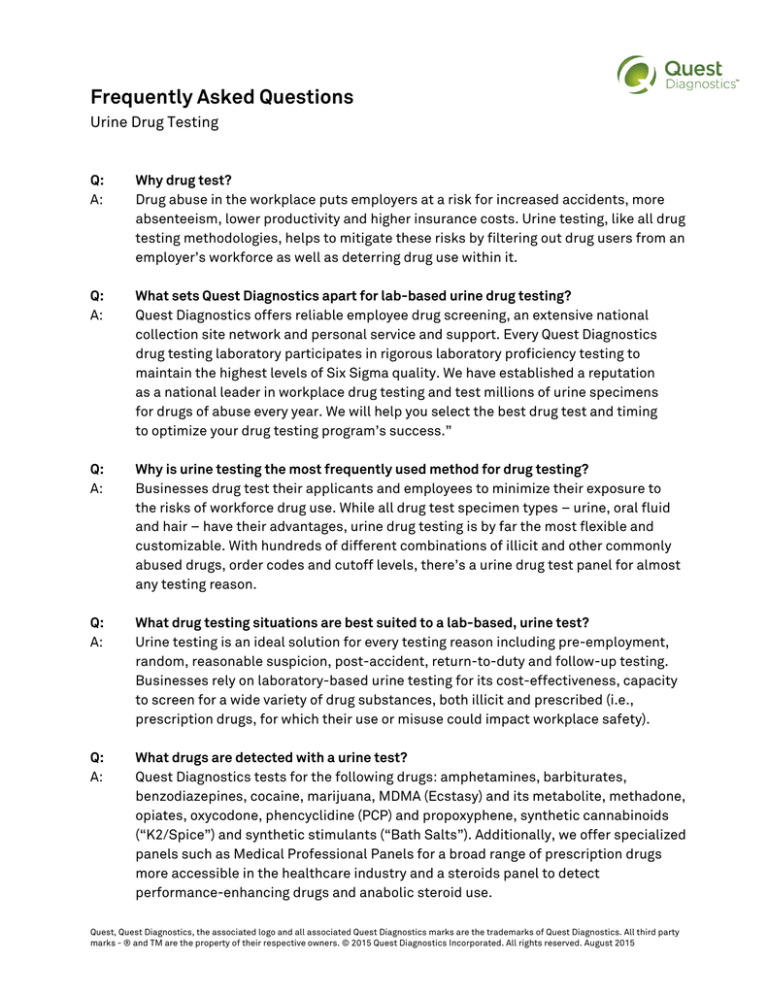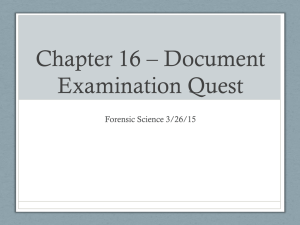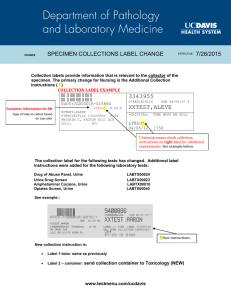
Frequently Asked Questions
Urine Drug Testing
Q:
A:
Why drug test?
Drug abuse in the workplace puts employers at a risk for increased accidents, more
absenteeism, lower productivity and higher insurance costs. Urine testing, like all drug
testing methodologies, helps to mitigate these risks by filtering out drug users from an
employer’s workforce as well as deterring drug use within it.
Q:
A:
What sets Quest Diagnostics apart for lab-based urine drug testing?
Quest Diagnostics offers reliable employee drug screening, an extensive national
collection site network and personal service and support. Every Quest Diagnostics
drug testing laboratory participates in rigorous laboratory proficiency testing to
maintain the highest levels of Six Sigma quality. We have established a reputation
as a national leader in workplace drug testing and test millions of urine specimens
for drugs of abuse every year. We will help you select the best drug test and timing
to optimize your drug testing program’s success.”
Q:
A:
Why is urine testing the most frequently used method for drug testing?
Businesses drug test their applicants and employees to minimize their exposure to
the risks of workforce drug use. While all drug test specimen types – urine, oral fluid
and hair – have their advantages, urine drug testing is by far the most flexible and
customizable. With hundreds of different combinations of illicit and other commonly
abused drugs, order codes and cutoff levels, there’s a urine drug test panel for almost
any testing reason.
Q:
A:
What drug testing situations are best suited to a lab-based, urine test?
Urine testing is an ideal solution for every testing reason including pre-employment,
random, reasonable suspicion, post-accident, return-to-duty and follow-up testing.
Businesses rely on laboratory-based urine testing for its cost-effectiveness, capacity
to screen for a wide variety of drug substances, both illicit and prescribed (i.e.,
prescription drugs, for which their use or misuse could impact workplace safety).
Q:
A:
What drugs are detected with a urine test?
Quest Diagnostics tests for the following drugs: amphetamines, barbiturates,
benzodiazepines, cocaine, marijuana, MDMA (Ecstasy) and its metabolite, methadone,
opiates, oxycodone, phencyclidine (PCP) and propoxyphene, synthetic cannabinoids
(“K2/Spice”) and synthetic stimulants (“Bath Salts”). Additionally, we offer specialized
panels such as Medical Professional Panels for a broad range of prescription drugs
more accessible in the healthcare industry and a steroids panel to detect
performance-enhancing drugs and anabolic steroid use.
Quest, Quest Diagnostics, the associated logo and all associated Quest Diagnostics marks are the trademarks of Quest Diagnostics. All third party
marks - ® and TM are the property of their respective owners. © 2015 Quest Diagnostics Incorporated. All rights reserved. August 2015
Q:
A:
What is the detection window for a lab-based, urine drug test?
Urine drug testing typically detects recent drug use in the previous 24 to 72 hours.
Q:
A:
What are the most common urine test panels ordered?
See the details about our standard 5-and 9-panel tests below.
Standard 5-panel (non-DOT testing)
Drug Group
Screen Cutoff
Confirmation Cutoff
Amphetamines
(amphetamine and
methamphetamine)
1,000 ng/mL
500 ng/mL
Cocaine metabolite
300 ng/mL
150 ng/mL
Marijuana metabolites
50 ng/mL
15 ng/mL
2,000 ng/mL
2,000 ng/mL
25 ng/mL
25 ng/mL
Screen Cutoff
Confirmation Cutoff
Amphetamines
(amphetamine and
methamphetamine)
1,000 ng/mL
500 ng/mL
Cocaine metabolite
300 ng/mL
150 ng/mL
Marijuana metabolites
50 ng/mL
15 ng/mL
2,000 ng/mL
2,000 ng/mL
Phencyclidine
25 ng/mL
25 ng/mL
Barbiturates
300 ng/mL
200 ng/mL
Benzodiazepines
300 ng/mL
200 ng/mL
Methadone
300 ng/mL
200 ng/mL
Propoxyphene
300 ng/mL
200 ng/mL
Opiates (codeine and
morphine)
Phencyclidine
Standard 9-panel
Drug Group
Opiates (codeine and
morphine)
Q:
A:
What is the standard turnaround time for a lab-based urine test?
Urine drug test specimens go through a two-tiered testing process at the laboratory.
The initial screening is performed on one portion of the specimen and is designed to
rapidly differentiate negative specimens from those that need additional testing, on
a different portion of the specimen, to confirm the outcome. Negative screening
results are often released within 24 hours and non-negative screens are typically
released within an additional 24 to 72 hours.
Quest, Quest Diagnostics, the associated logo and all associated Quest Diagnostics marks are the trademarks of Quest Diagnostics. All third party
marks - ® and TM are the property of their respective owners. © 2015 Quest Diagnostics Incorporated. All rights reserved. August 2015
Q:
A:
Can a urine drug test be beaten or adulterated?
While it is the most common drug testing method, urine testing is not foolproof. With
our TestSure™ specimen validity testing, we can help ensure the integrity of the test
by measuring pH, creatinine and specific gravity (when indicated) and testing for
adulterants that may be added to the urine specimen. The most common adulterants
screened include oxidizing agents – such as, nitrites, chromates and halogens (e.g.,
bleach and iodine). Quest Diagnostics is one of the few laboratories to offer oxidant
identification for some of the most common oxidizing adulterants. All “invalid results”
are automatically tested twice to ensure accuracy. We also offer oxidizing adulterant
identification if requested by the customer or Medical Review Officer.
Q:
A:
How is a urine drug test collected?
Urine drug testing requires a minimum of 30 mL of urine (45 mL for a Department of
Transportation collection) collected in the privacy of a restroom. The collector pours
the specimen into a bottle that is sealed with tamper-evident tape. The specimen
and completed Custody and Control Form (CCF) are sent to the laboratory for testing.
Quest Diagnostics collection sites maintain an on-site inventory of urine testing
supplies so your donors simply need to show up with their documentation and provide
their specimen.
Q:
What training does a Quest Diagnostics collector receive prior to performing a urine
drug test collection?
We hold our collection sites to the highest standards of quality and professionalism.
We follow Department of Transportation (DOT) collector training protocols that include
qualification training (e.g., instructional videos online collection training, and tests)
as well as “mock” collections designed to ensure proper training. In addition, we
validate that sites follow the standard protocols by performing audits and conducting
anonymous “mystery shopper” programs. If an issue is discovered, we recommend
options for immediate correction.
A:
Q:
A:
Where do I send a donor for a urine drug test?
Quest Diagnostics provides access to a nationwide network of more than 8,000 drug
test collection sites, including more than 1,200 company-owned and operated Quest
Diagnostics Patient Service Centers and more than 1,500 preferred third-party
locations. Typically, a location is conveniently located nearby.
Q:
A:
Can a donor walk in without an appointment?
Yes. However, appointment scheduling is recommended as it will help to reduce
wait times. A donor can schedule at QuestDiagnostics.com by clicking Make an
Appointment. Under Reason for testing, enter geographic information and choose
drug screen and then urine. Donors can select a convenient location, date and time.
Quest, Quest Diagnostics, the associated logo and all associated Quest Diagnostics marks are the trademarks of Quest Diagnostics. All third party
marks - ® and TM are the property of their respective owners. © 2015 Quest Diagnostics Incorporated. All rights reserved. August 2015
Q:
A:
Do you offer an emergency urine drug test?
Yes. Our nationwide network of more than 6,000 certified collectors provides around
the clock access to emergency drug collections for post-accident or reasonable cause.
With a nationwide network of more than 200 dispatch offices, we’re there with an
average response and collection time of less than two hours.
Q:
A:
Do you offer on-site urine drug tests for events such as a job fair?
Yes. Performing collections at your place of business or job site offers benefits
including simplified logistics and the convenience of not having to coordinate the
collection process. Through our mobile, on-site collection service, we make it easier
for you and your employees to provide specimens for testing. Another option for
testing is our Express Results™ Online instant, urine test with speed that helps
to hire candidates quickly. It detects up to 11 commonly-abused drugs.
Q:
A:
Is a urine drug test approved for Department of Transportation testing?
Yes, urine testing is the only drug test type approved for federally-mandated drug
testing. To follow standardized procedures established by the Substance Abuse and
Mental Health Services Administration (SAMHSA) and the DOT, urine test results are
evaluated by a Medical Review Officer after the urine specimens have been tested
for five classes of drugs (amphetamines, cannabinoids, cocaine, opiates and
phencyclidine) in a SAMHSA-certified laboratory. The DOT’s rule 49 CFR Part 40
describes required collection procedures for conducting workplace drug and alcohol
testing for the federally regulated transportation industry.
Q:
A:
Will a urine drug test stand up in court?
Quest Diagnostics has been performing urine testing for drugs of abuse for more than
25 years. From the beginning, we have stood behind every drug test result reported by
our laboratory. Our results have successfully withstood legal challenges in workplace
testing, military proceedings and other civil jurisdictions. Our proven track record of
success supports the fact that we provide reliable, accurate urine drug testing results
that you can depend on.
Q:
A:
What testing methodology is used?
For most urine drug tests, the initial screen is performed using Enzyme Immunoassay
(EIA) methodology. EIA involves a binding reaction between the target drug and/or drug
metabolite and an antibody producing a signal that is detected by automated
instruments indicating whether the target compound might be present in the
specimen. This technology provides fast, efficient separation of negative specimens
from those that require further testing. Confirmatory drug tests for the non-negative
specimens are performed with Gas Chromatography – Mass Spectrometry (GC/MS) or
Liquid Chromatography – Mass Spectrometry (LC/MS) methodology. These
instruments are capable of specifically identifying and distinguishing the drug or drug
Quest, Quest Diagnostics, the associated logo and all associated Quest Diagnostics marks are the trademarks of Quest Diagnostics. All third party
marks - ® and TM are the property of their respective owners. © 2015 Quest Diagnostics Incorporated. All rights reserved. August 2015
metabolite from other compounds that might be present in the specimen. At the
same time, they can accurately measure the concentration of the target compound.
Q:
A:
What certifications does Quest Diagnostics maintain?
Our laboratory certifications and accreditations include SAMHSA (urine), CAP-FDT
(hair, oral fluid, and urine), Florida (hair and urine), and New York State (hair, oral fluid
and urine), as applicable for the specific testing menu and customer base for each lab.
When you work with Quest Diagnostics, you are partnering with a drug testing leader.
Q:
Where are your laboratories located?
Quest Diagnostics has four SAMHSA-certified laboratories that offer broad testing
capacity and redundancy. They are located in the Atlanta, Kansas City, Los Angeles
and Philadelphia areas.
Q:
A:
How are the results reported?
As with all laboratory-based drug testing, test results are logged into the laboratory
information system and reported to the customer or Medical Review Officer by a direct
interface, web reporting, confidential fax, printer or voice response.
Q:
A:
How long are urine drug test specimens maintained?
Laboratory test results and records are maintained for a minimum of two (2) years.
Note: Specimens that test negative are destroyed after 5 days, while specimens that
test positive are maintained in frozen storage for a minimum of 1 year.
Q:
A:
Where can I find information on drug usage trends in the U.S.?
We publish the Quest Diagnostics Drug Testing Index™ (DTI) as a public service for
government, media and industry. It has been regarded as a benchmark for national
drug positivity trends since first summarizing data from 1988. The strengths of the
Drug Testing Index analysis include its large sample size, the longitudinal nature of the
monitoring, a testing population that is generally reflective of the U.S. workforce and
the quality of our company’s drug testing services to confirm positive test results. The
latest report and analysis can be found at QuestDiagnostics.com/dti.
Q:
A:
How much does a lab-based urine drug test cost?
The cost of the urine drug test will vary based upon volume and the number of drug
panels selected. Also, the cost is lower if the collection takes place at a Quest
Diagnostics Patient Service Center. Please contact your Sales or Account Management
representative for more information.
Q:
A:
Who should I contact with questions about urine drug testing from Quest?
Contact your Sales or Account Management representative for more information or call
our National Customer Support Center at 800-877-7484.
Quest, Quest Diagnostics, the associated logo and all associated Quest Diagnostics marks are the trademarks of Quest Diagnostics. All third party
marks - ® and TM are the property of their respective owners. © 2015 Quest Diagnostics Incorporated. All rights reserved. August 2015





